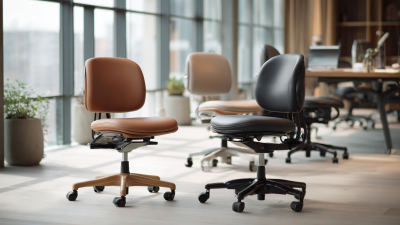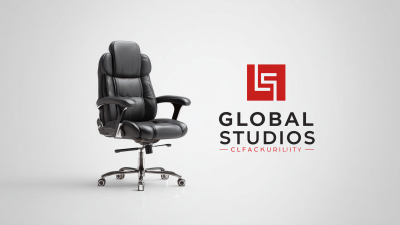Revolutionizing Comfort: The Science Behind Ergonomic Stool Chairs for Improved Posture and Productivity
As the modern work environment evolves, the significance of ergonomics in promoting health and productivity cannot be overstated. The rise of the "Ergonomic Stool Chair" has marked a pivotal shift in workplace design, providing a solution to the common ailments associated with prolonged sitting. According to a study published by the Occupational Safety and Health Administration (OSHA), poor posture can lead to musculoskeletal disorders, affecting more than 30% of office workers annually. Furthermore, research from the National Institute for Occupational Safety and Health (NIOSH) indicates that ergonomically designed seating can enhance focus and performance by up to 25%. The implementation of Ergonomic Stool Chairs not only encourages optimal spinal alignment but also fosters greater workplace comfort, ultimately leading to improved productivity. In light of these compelling statistics, it is crucial for businesses to consider the adoption of such innovative seating solutions to cultivate a healthier and more efficient work environment.

Understanding the Importance of Ergonomics in Seating Solutions
Ergonomics plays a crucial role in seating solutions, particularly in the design of ergonomic stool chairs that promote better posture and increase productivity. According to a report from the Occupational Safety and Health Administration (OSHA), improper seating can lead to musculoskeletal disorders, which affect nearly 30% of the workforce each year. This highlights the significance of integrating ergonomic principles into office environments, where individuals often spend long hours sitting.

Research conducted by the American National Standards Institute (ANSI) indicates that ergonomic seating can reduce fatigue and discomfort, improving overall employee performance. Ergonomic stool chairs are designed to offer a dynamic range of motion while supporting the natural curvature of the spine. A comparison of workplace environments showed that organizations that have adopted ergonomic seating saw a 20% reduction in workplace injuries, further underlining the importance of investing in ergonomically sound products. By prioritizing ergonomics in seating solutions, employers not only enhance employees' well-being but also foster a more productive and motivated workforce.
Key Features of an Ergonomic Stool Chair for Enhanced Comfort
When it comes to choosing an ergonomic stool chair, key features play a critical role in enhancing comfort, posture, and productivity. Firstly, adjustability is paramount; a stool should have height and seat angle adjustments to accommodate various body types and workspaces. According to a 2021 study from the International Journal of Human Factors and Ergonomics, adjustable seating can reduce the risk of chronic back pain by up to 50%. This emphasizes the importance of personalized adjustments to support one's natural posture.
Secondly, the material of the stool significantly affects comfort levels. Chairs designed with breathable fabrics and adequate cushioning can improve airflow and reduce fatigue during prolonged use. A report from the Ergonomics Society highlights that comfort is directly linked to performance, indicating that a well-designed stool can boost productivity by as much as 20%.
Tips: When selecting an ergonomic stool chair, always test for stability and comfort. Look for a chair that offers a wide base and anti-slip features for safety. Additionally, consider incorporating regular breaks to stand and stretch; this complements the ergonomic benefits and enhances overall well-being.

Techniques to Adjust an Ergonomic Stool Chair for Optimal Posture
Adjusting an ergonomic stool chair is essential for achieving optimal posture and enhancing productivity. The first step involves setting the height of the stool to ensure that your feet are flat on the ground, allowing for a stable base and proper circulation. When your knees are at a 90-degree angle, your hips will align comfortably, reducing strain on your lower back. It's important to sit back fully against the chair's backrest, promoting lumbar support that encourages a natural spinal curve.
Additionally, the angle of the seat can significantly affect your posture. A slight tilt forward can facilitate an active sitting position, engaging your core muscles and prompting better alignment of the spine. The armrests, if present, should be adjusted to allow your shoulders to relax, preventing tension build-up in the neck and upper back. Regularly reassessing these adjustments throughout the day can help maintain comfort and support an efficient work environment, ultimately leading to improved focus and productivity.
Incorporating Movement: The Role of Active Sitting in Productivity
Active sitting has emerged as a revolutionary approach in workplace ergonomics, aligning comfort with productivity. Research from the American Journal of Industrial Medicine suggests that incorporating dynamic seating solutions, such as ergonomic stool chairs, can lead to noticeable improvements in posture and energy levels throughout the workday. The study found that employees who utilize active sitting solutions report a 15% increase in overall productivity due to enhanced engagement and reduced discomfort during long hours of seated work.
Moreover, the concept of active sitting encourages frequent movement, minimizing the negative effects of prolonged sitting. According to a report from the Centers for Disease Control and Prevention, sedentary behavior can significantly increase the risk of chronic health issues, which can ultimately affect work output. Ergonomic stool chairs enable individuals to shift their weight, adjust their position, and maintain core engagement, fostering a healthier work environment. By redefining traditional seating, these innovative designs not only improve posture but also contribute to sustained focus and efficiency, proving that movement is indeed a critical component of productive work practices.
Maintenance Tips for Maximizing the Lifespan of Your Ergonomic Stool Chair
To maintain the longevity of your ergonomic stool chair, regular cleaning and maintenance are essential. Start by wiping down the chair with a damp cloth to remove dust and debris. For deeper cleaning, a mild soap solution can be applied, but ensure it doesn’t seep into any cracks or crevices that might harbor moisture. Pay special attention to the cushioning and fabric, as spills can quickly lead to stains or damage if not addressed promptly.
Another important aspect of maintenance is to regularly check the chair's adjustments and mechanisms. Over time, the gas lift or tilt functions may become less responsive due to wear. Make sure to adjust these components as needed and lubricate any moving parts to ensure smooth operation. Additionally, inspect the base and wheels for any signs of wear or damage, as these affect stability and mobility. By prioritizing maintenance tasks, you can significantly extend the life of your ergonomic stool chair and continue to enjoy the benefits of improved posture and productivity.
Related Posts
-

Top 5 Executive Boardroom Chairs: Innovations and Trends Shaping Modern Offices
-

Transform Your Workspace: The Essential Guide to Choosing the Perfect Office Armchair
-

The Future of Ergonomics: Elevating Comfort with the Best Office Chair Stool
-

Global Market Leadership with Best Office Chair Stools from China Focus on Quality and Innovation
-

Discover How China's Top Quality Factories Redefine Global Standards for Best Leather Executive Chairs
-

5 Essential Tips for Choosing the Best Nesting Chairs for Your Space